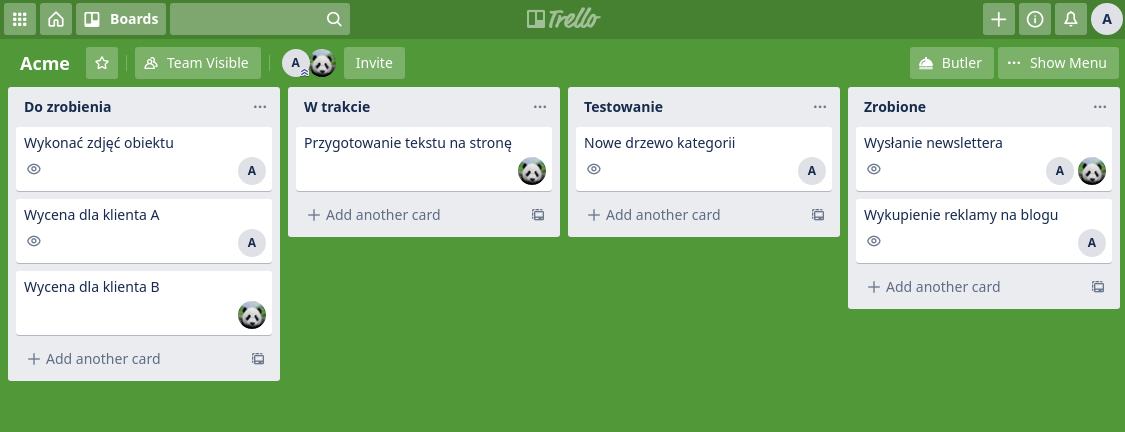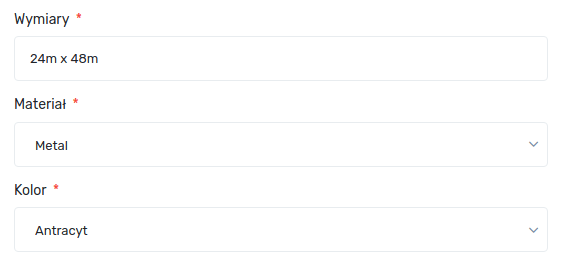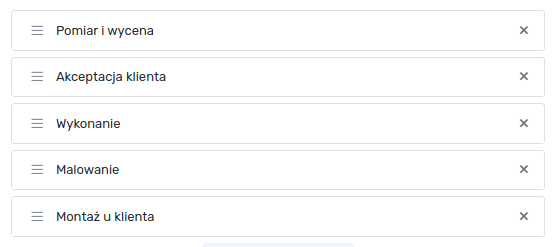If you are planning to start working with Fortask and have used Trello so far, this article is just for you. We will show you how to transfer cards from Trello to Fortask application in the form of tasks. At the end of the article we will also summarize the benefits this will bring to your team.
We have to start from scratch. Trello as an application by default does not introduce any standard, which means that the way it is used by a given team may differ significantly. Everything depends on the needs and imagination of the team. Despite the differences, it is quite easy to notice similarities in boards of individual companies. Of course, the naming of even the columns will differ, but one rule is often duplicated. Namely, it is about the way the columns on the board are organized. Most often the name and purpose of the columns refers to the individual stages of the task. The simplest example can be the following configuration of columns:
- To do
- In progress
- Test
- Done

I'm sure this form is clear to everyone. New tasks are added in card form and initially placed in the To Do column. Then, after starting the work, they are moved to the column in progress. When finished, they are placed in the Testing column to be moved to the Finished section at the end. The persons responsible for the execution are assigned to the card. Additionally, we can assume that one person is always responsible for the tests and this takes care of the cards that will be placed there.
However, the above example is very simple and often does not work in larger companies, where many people are involved in the task and the process itself is much more complicated. Therefore, I will present a second example of a more complex board.
- Measurement and valuation
- Customer acceptance
- Production
- Painting
- Mounting
- Completed

In this case, as you can see, each column is related to a specific stage of the task. You can also immediately guess that many people are involved because usually the measurement and valuation is done by a completely different person than painting.
Although there is no recommended Trello configuration recipe anywhere, the above examples are quite common practice in many companies. Of course we will not focus on the pros and cons in the context of the Trello application itself. We will focus on how to move such an array from Trello to Fortask.
At the beginning we have to realize that Fortask is an application that is fundamentally different from Trello already at the stage of the very concept of the task execution. In our application we focus on the tasks and they are the basic element. Each task has its own status and can also consist of smaller components called sub-tasks. Each subtask performed by different people also has its status.
In our application the above mentioned task could look like this:

As you can see at first glance, this task is assigned five sub-tasks. Each of them is the responsibility of a different person. In this way, in the task we have transferred all the stages of work that make up the whole task. Note that we have not placed any subtasks for the Realised column. Why? Because in Fortask application, after all subtasks have been completed, the task receives the status Solution.
In practice, it looks like that as soon as the task is completed, the whole task will have the status Waiting, As soon as one of the people starts or completes its part and selects the status for the sub-task Ongoing or Solved, the whole task will get the status Ongoing. When all subtasks are solved, the task will change its status to Solved.
As you can see in Trello, the implementation process is based on juggling the card (task) in individual columns depending on the stage performed. In Fortasek, a task is an element that contains all the stages inside and it is there that they are marked as completed.
We discussed the basic issue of how to work with the task in Trello and Fortasek. Now you can probably think what else you will gain by using our application. Basically, there are many advantages, but let me list exactly three, which in my opinion are most interesting.
- Relation between sub-tasks.
The first aspect I would like to address is essentially a simple function. Namely, by defining the stages of work in a given task you can also define the order of their execution. This will prevent a situation in which, for example, your employee will start making the product when you have not yet finished negotiations with the customer and you do not know whether the order will be finally executed. - To carry out several stages in parallel.
If you are a regular Trello user I'm curious how you deal with the situation, when with the above presented division of columns there is a situation where two actions are performed in one moment. For example, Perform and Paint. In such a situation you create another column "Execution/Painting" or are you just trying to remember that such a situation takes place?
In our application in this case the situation is obvious and transparent. Just two or more subtasks have their status set to Ongoing. This way, everyone who is interested knows exactly what is happening at the moment.
- Task templates.
I'll take another look at the situation that could happen with Trello. The example shown above reflects the table in the case of tasks directly related to the valuation and production of the order for the customer. However, one board often does not exhaust the needs of the company. Let's imagine that apart from the order execution itself, the company also orders materials, conducts retail sales in an online shop, etc. Each of these branches of activity is characterized by a different set of stages to be performed. It cannot be realized on one whiteboard, which results in the fact that the whiteboard has only a few at best.
Task templates are used to improve and automate task creation. They have essentially two applications. The first one is that we can define in the template the input parameters that should/can be given when creating a task.

Thanks to this, the most important information will always have the same form/name, and most importantly, no one will forget to place it by adding a task.
The second application is the ability to define default sub-tasks for a given template. As a result, after adding a task with a given template, the sub-task list will be created by default. This solution saves a lot of time.

Going further, you can define task templates for order processing, material purchase, retail, store development. Each of them will have different input parameters and a list of sub-tasks to be executed. Ultimately, each of the tasks will be visible on one list without having to switch between different areas.
The advantages of the task templates are described in more detail in previous article: Improving the efficiency of task solving through task templates. We encourage you to read these materials.
As you can see, the transition from Trello to Fortaska is as possible. Of course, this requires a change in the approach to the task itself and the stages it takes. Nevertheless, I hope that I have convinced you that the logic of sub-tasks and their implementation in our application is logical and clear. If you haven't had a chance to use Fortask application yet, I strongly encourage you to create a free account.



